Vigna(Cochliasanthus) Caracalla
Garden vines can transform incredibly large areas in a short time by draping them, while they amaze with their diversity. Vines include both exotic and classic cultures. The plant of the cowpea Caracalla, which is also called snail grapes, belongs to the exotics. Its stems can grow up to seven meters long, and among the rest, this vine stands out for its very unusual flowers, which outwardly resemble a snail. This plant is widely grown not only in gardens, but also indoors, and it is remarkable both for its unusual flowers and spectacular leaves. It quickly and easily braids almost any support.
Features of cowpea caracalla
Table of Contents
Vigna caracalla is a very spectacular and unusual plant. All the beauty of this curly liana cannot be described in words, it is so unusual and effective. The flowering plant looks the most spectacular and exotic. Among the people, he has several more names, namely: “corkscrew flower”, “snail grapes” and “grape snail”.
The perennial vine vigna Caracalla is part of the legume family. The length of the climbing stems can be up to 500-700 cm. The leaves of the plant are particularly beautiful. Tripartite leaf plates of a dark green hue have thin pointed tops. They form a dense lace background, on which unusual flowers look especially luxurious. The glossy surface gives the foliage even more beauty.
The most “exotic” part of the Caracalla cowpea is its flowers. The large bract has an elongated shape, while it is curved and twisted in such a way that it bears a vivid resemblance to a corkscrew or a snail. During flowering, gorgeous large inflorescences are formed on the stems, consisting of flowers that are twisted into tight spirals. The racemose inflorescence is rather dense and large. Flowering is observed during all summer months, and even at the beginning of the autumn period. Moreover, at any time on the shoots, you can see both already opened flowers and only buds that are tied.
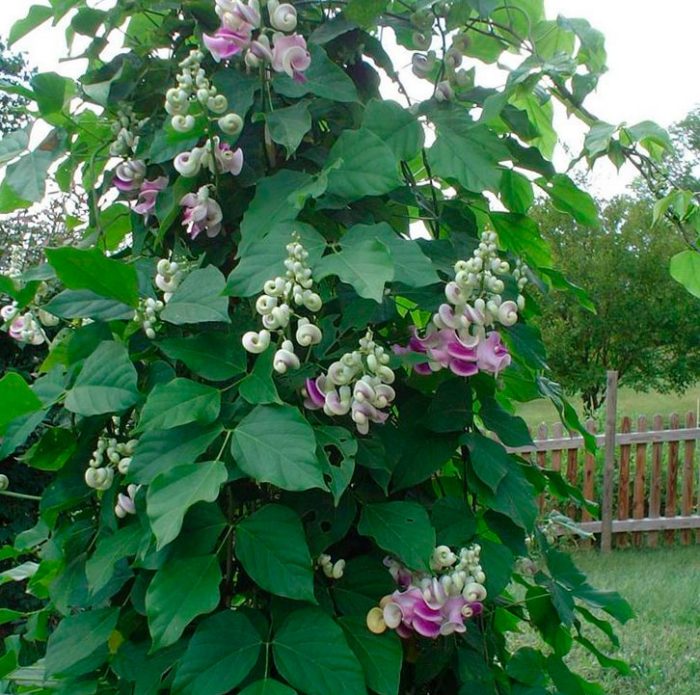
The color of flowers in snail grapes is also unusual, watercolor. It is almost impossible to find a bush on which there would be monochromatic inflorescences. Almost all varieties are distinguished by the fact that their flowers are colored in 2 or 3 tones, while they have soft smooth transitions. The flowers can be colored in various combinations of shades such as pink, yellow, purple, white, cream, and purple. Unusual flowers stand out not only for their shape and color but also for their delicate, very pleasant aroma, which is perfectly felt up close. The scent of this exotic liana is very similar to the scent of hyacinth.
The cowpea Caracalla blooms for a long time. As a rule, flowers on a bush can be seen throughout the summer and early fall. The liana blooms in July and stops blooming immediately after the first frost because it turns out to be detrimental to the heat-loving plant.
In place of the wilted flower, a fruit is formed in the shape of a pod. Inside it is beans that you can eat. The fruits of the cowpea Caracalla are known all over the world under the name “Mexican beans”.
Vigna caracalla in landscape design

Vigna caracalla is a spectacular liana that is not particularly hardy. In the open field, it can only be cultivated where it comes from, namely in Central and South America. In those regions where winters are frosty, planting vines in the ground is not done. The fact is that in a harsh climate, it grows very poorly and may even die since it needs a stable temperature and certain conditions for normal growth. However, it may well be cultivated as a potted garden plant.
This plant is most commonly used as:
- balcony culture;
- a potted liana dug in the garden in the warm season;
- the decor of recreation areas and terraces.
Snail grapes grow and develop fully when grown in a pot. He quickly braids any support, attaching to it with his antennae. The vine grows incredibly fast, in just 24 hours it can grow to a height of about 30 centimeters. In this regard, it is necessary to carry out regular pruning, which helps to curb the exuberant growth of exotic.
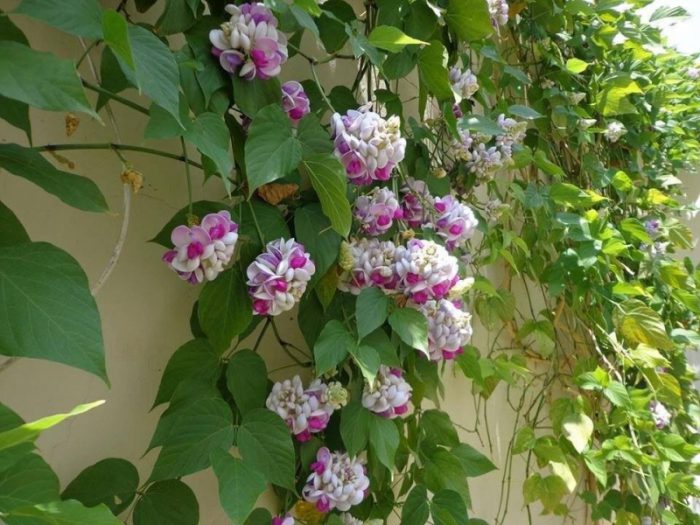
This spectacular culture is used for:
- decoration of walls and hedges;
- the formation of green screens, as well as living screens;
- for cultivation as an ampelous plant;
- disguises;
- creating the effect of a blooming cascade, waterfall, or fountain.
Please note that the plant must be in the same location throughout the season. You cannot transfer it from one place to another. The fact is that the stems of the liana are distinguished by their fragility, so they can easily break. In this regard, before moving the bush to the garden, you must first choose a suitable place for it.
With the onset of cold weather, the liana is cut off and brought into a heated room. But if you wish, it can be used as a summer flyer. And after the plant dies from the first frost, it is simply thrown away. Perennial and one-year-old cowpea Caracalla need to be looked after in almost the same way, the only difference is the frequency of fertilization.
Optimal conditions
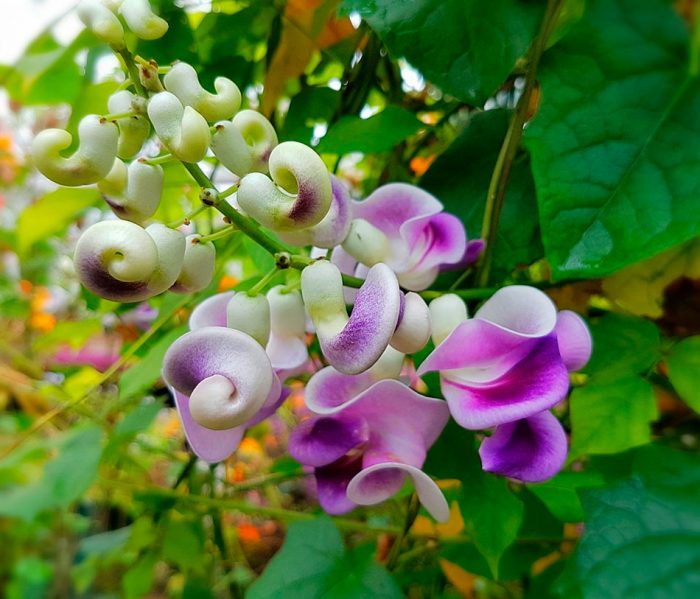
Liana vigna Caracalla is one of the light-loving cultures. If you choose a place for her, even with a little shading, then this will have an extremely negative effect on her appearance: the foliage will fade and begin to fly around, the stems will be very elongated, the flowers will be small, and the flowering itself will be difficult to call abundant. In this regard, it is recommended to give preference to the most illuminated places on the terrace, in the open ground, and on the balcony.
Also, remember that a place suitable for such an exotic place should be very warm and cozy, it should have reliable protection from cold drafts. When the air temperature drops to 3 degrees, the plant may die. And at zero degrees, there is an active dying off of the stems of snail grapes. However, if the frost was not too strong, and after it, warm weather sets in, then the roots will give new young shoots.
Pay particular attention to the choice of soil mixture for this plant. It must pass air and water well, be of high quality, loose, and contain a large number of nutrients. For planting vines, you can purchase a ready-made universal soil mixture in a specialized store, but if you wish, you can prepare the substrate yourself.
Planting Cowpea Caracalla
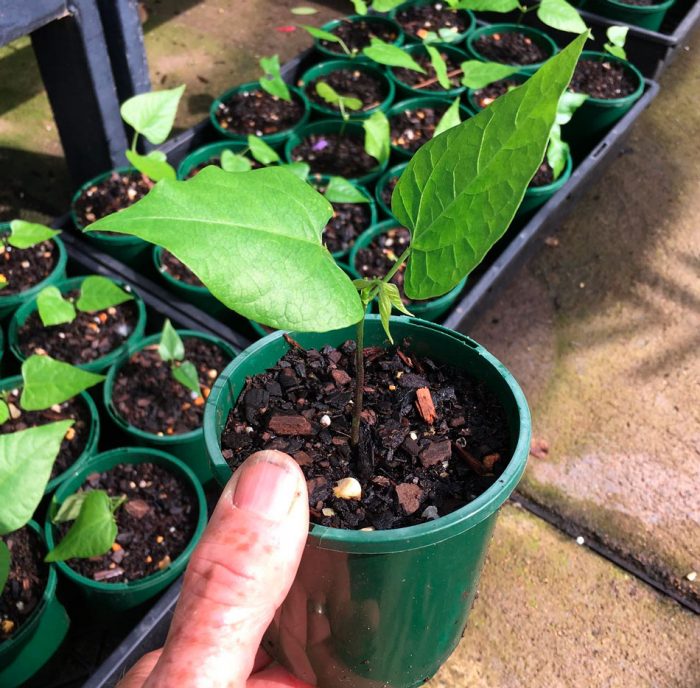
For planting cowpea Caracalla, you should choose a spacious large container. Note that there should be fairly large drainage holes at the bottom of the pot. Also, a thick drainage layer must be laid out at the bottom; for this, you can use shards, largely expanded clay, and gravel. Install the bush so that the root collar is flush with the surface of the substrate, it cannot be buried. When transplanting, try not to damage the root system and keep the clod intact.
The bush is transferred to open ground only when the threat of spring return frosts has passed. Typically, this time falls in May or June.
If you need this vine for horizontal gardening or to fill a rather large area, then it is buried in the soil together with the pot. To do this, dig a hole that will correspond to the size of the pot, while at the bottom you need to make a good drainage layer.
Caring for cowpea caracalla
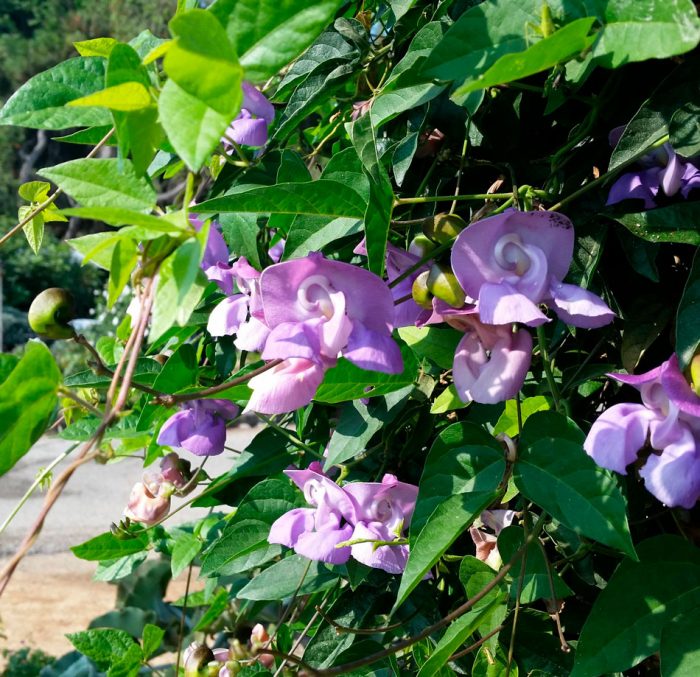
Since the Caracalla cowpea is characterized by very fast growth, it will require special attention from gardeners.
Watering
The plant is not afraid of a short drought. However, in order for it to bloom magnificently and effectively, it is necessary to ensure that the soil mixture is always moist. After a short time after watering, be sure to empty excess water from the pan. Make sure that no liquid stagnation occurs in the soil mixture. Moisten the substrate only after the top layer has dried. If you grow snail grapes as a perennial, then in winter water it more rarely and scarcely, the soil mixture should be only slightly moist.
Topdressing
Since the vine grows very quickly and is large in size, it will need frequent feeding. If you grow a liana as a perennial, then you need to feed it once every 20-30 days. Bushes grown as annuals are fertilized once a week. A combined mineral and organic fertilizer are suitable for the Caracalla cowpea. At the very beginning of the growing season, the bush can be fed with nitrogen. For the rest of the dressings, it is recommended to use universal fertilizers or mixtures for flowering plants.
Garter
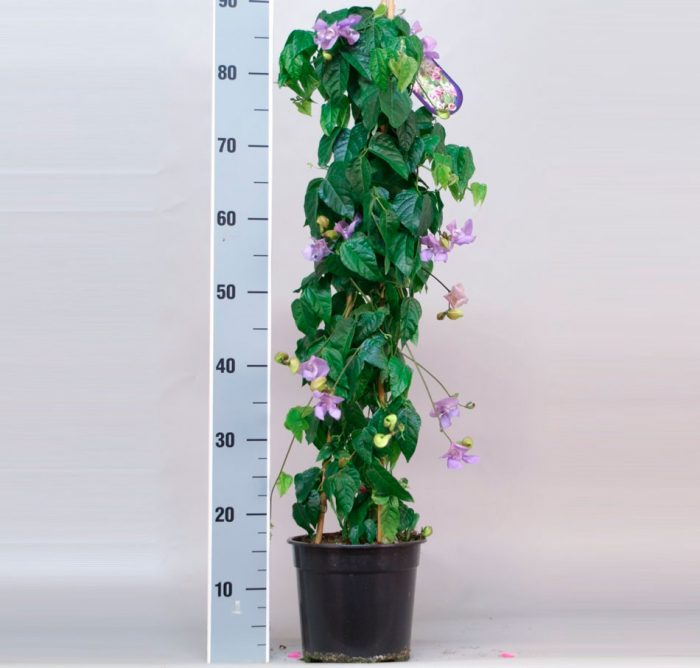
Take care in advance of reliable support for the Caracalla cowpea. However, it can be used to create a cascade with plinths or to grow as an ampelous crop. For this vine, it is recommended to use stretched rows of twine or a special mesh. Shoots climb up such supports very quickly, clinging to them with antennae. There are permanent supports (for example, wood gratings), as well as temporary ones, which are installed for one season.
You do not need to tie up lianas. The fact is that it is securely fixed on the support, clinging to it with antennae. The plant grows rapidly and braids the support literally before our eyes. However, in order for the plane to be filled efficiently and completely, you will need to direct the stems in the right direction.
Pruning
You should be especially careful about pruning. From the very beginning of the growing season, you need to regularly pinch the tops of young stems. Thanks to this, the flowering will be more lush and spectacular. As the bush grows, when it fills the entire area allotted for it, you will have to regularly trim the stems to the required size, and you will also need to cut off excess antennae.
Winter care
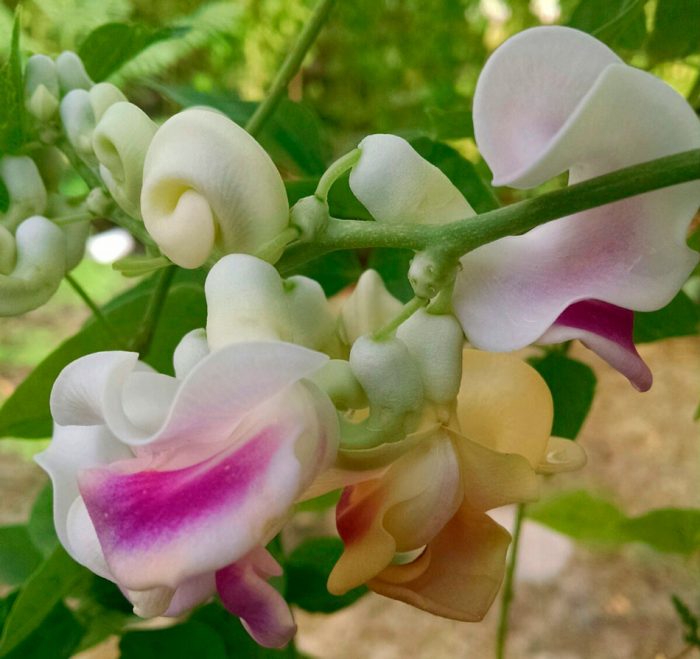
If you want to grow the cowpea Caracalla as a perennial crop, then in winter it will have to be in a heated room. After the plant from the street is brought into the room, it stops growing and developing. The bush goes into a dormant state. For wintering for such a vine, it is recommended to choose a room with an air temperature of 5-12 degrees.
After it starts to get colder outside, you should prune the vines. To do this, its shoots are shortened to 0.2–0.3 m, while the green mass must be completely removed. If in the summertime the bush was dug into the ground along with the pot, then it should be carefully dug out and the same pruning carried out as described above. Carefully clean the outer surfaces of the container from residual soil.
Diseases and pests
Vigna caracalla is highly resistant to fungal diseases. However, if a bush infected with powdery mildew or rust grows nearby, then the plant can become infected from it. If the vine is grown on a closed terrace or balcony, then it will be more susceptible to whitefly and spider mite damage. To get rid of pests, it is recommended to increase the level of humidity in the air and treat it with a suitable insecticidal agent.
Reproduction methods
Growing from seeds
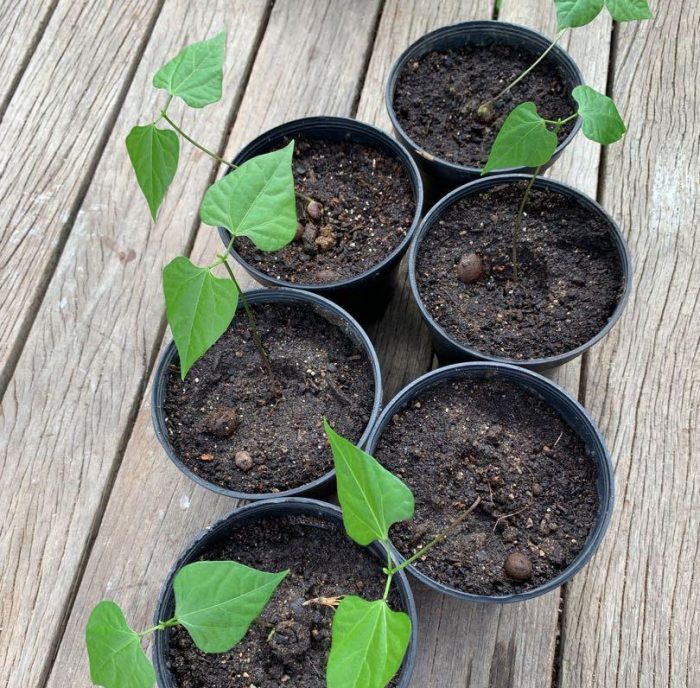
Vigna Caracalla can be grown from seeds. To begin with, they are poured with warm water for one day. A small container is filled with fertile soil mixture, after which the seeds are buried into it by 10–20 mm. From above, the container is covered with glass or film and transferred to a well-lit and warm place. After the formation of the third true leaf plate, the seedlings are picked into separate pots.
Reproduction by layering
In summer, select a strong, healthy stem and anchor it to the surface of the soil mixture that is filled into a small pot. Carry out regular moistening of the soil mixture in the pot and after a while roots will appear on the shoot. After that, it is cut from the parent plant and planted in a permanent pot.
Cuttings
Cuttings are harvested in the autumn, combining it with full pruning. Fresh cuttings are planted in individual containers. The roots on the cuttings will grow back after 15–20 days. In winter, they are kept in a cool room in which they slow down their growth and development. With the onset of spring, the cuttings quickly turn into lush bushes.
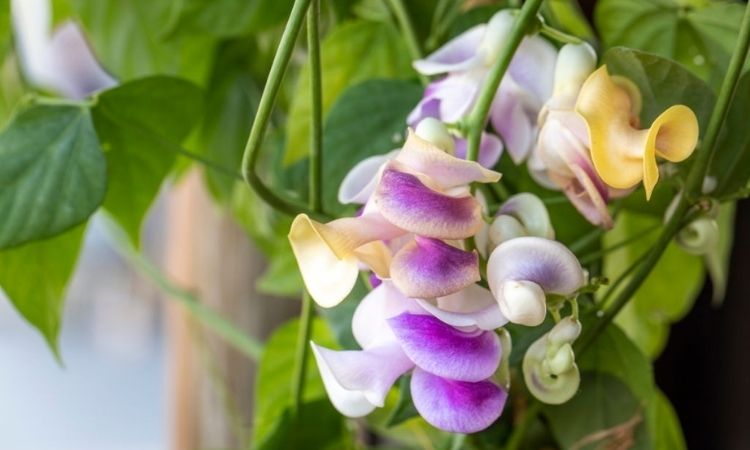
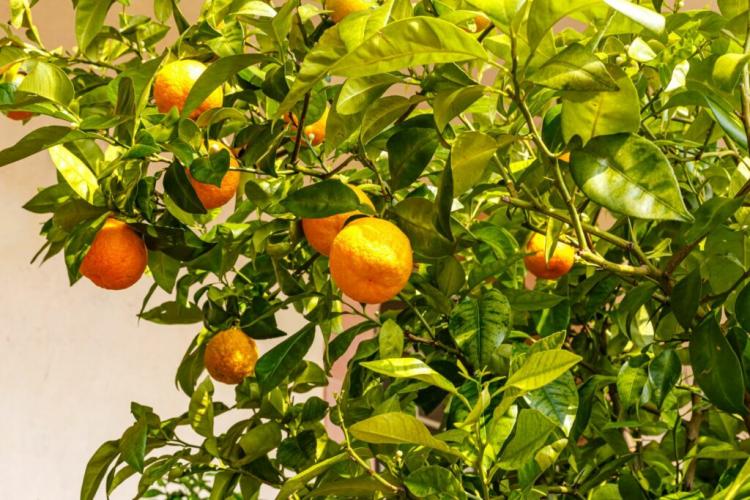
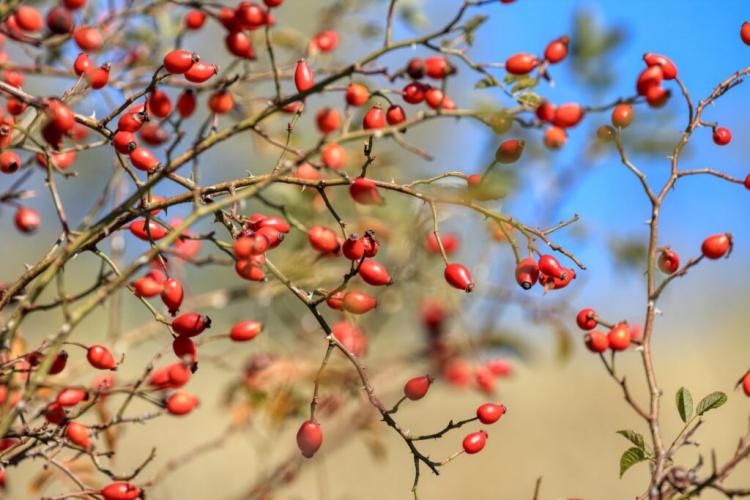



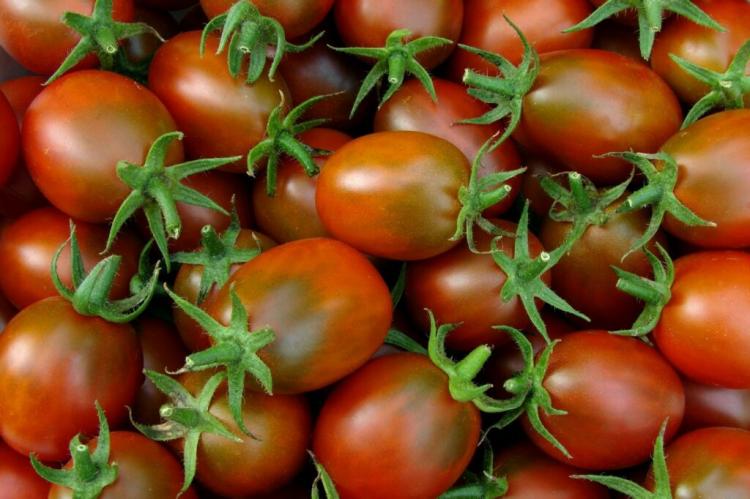
Hello Linda , I am having a great deal of difficulty finding a snail or corkscrew vine ? Can you help me please ?
Not sure where you are from but Tesselar plants in Australia sell them online.
Cheers Di